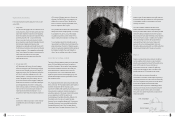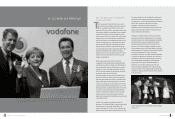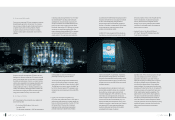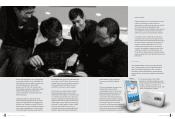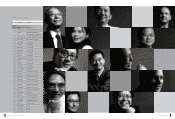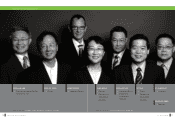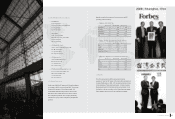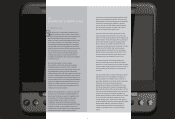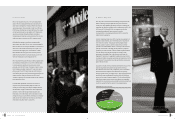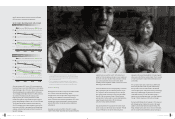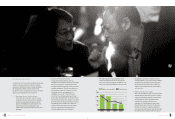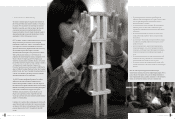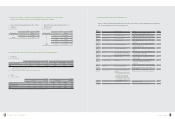HTC 2008 Annual Report Download - page 17
Download and view the complete annual report
Please find page 17 of the 2008 HTC annual report below. You can navigate through the pages in the report by either clicking on the pages listed below, or by using the keyword search tool below to find specific information within the annual report.
2OO 8 HTC AN N UAL REPO RT
2928
III.
BUSINESS OPERATIONS
consumers are increasingly replacing their traditional mobile
phone sets with handheld 'smart phones'. These trends are
helping support continued buoyant smart phone sales growth
in spite of the worsening overall conditions in the global
economy seen since 3Q 2008. Nokia indicates that global
sales of smart phones topped 160 million units in 2008 - a
33% rise over sales during the previous year.
Launches of HTC Touch and the original iPhone in 2007
uncorked general market demand for touch screen smart
phones. HTC then launched in 2008 the world's first 3D touch
screen interface in the ground-breaking HTC Touch Diamond
series of 3G smart phones. Apple also upgraded original
iPhone functions in the release of the Apple iPhone 3G.
These product launches fired growth trends further, into which,
from the second half of 2008, other competitors began
launching touch phone models of their own, including the
Blackberry Storm, Samsung Omnia and Nokia N97. HTC's
pioneering efforts in this highly successful sector give it a
technological lead over competitors of at least a year.
Consumers increasingly reflect individual lifestyle and
personality preferences into their mobile phone purchase
decisions. HTC works consistently to infuse greater innovative
and technological diversity into its product solutions to ensure
its product offering is well received by a broad spectrum of
consumers.
Following intensive efforts to optimize mobile phone interface
ergonomics and improve user satisfaction, mobile phone
operating systems have migrated toward convergence on
open system standards. Led by Internet search engine leader
Google, the Open Handset Alliance has promoted
aggressively the development and utilization of open code
Android operating software to support leading edge mobile
phone applications. Nokia, after acquiring Symbian in 2008, is
in the process of making Symbian system codes open source
in order to encourage more widespread development of
Symbian-based mobile phone software applications. T-Mobile
G1, the world's first mobile phone designed around the
Android operating system, was launched in 2008, joining a
market dominated by mainstream operating systems Symbian,
Windows Mobile, Blackberry and iPhone. Leveraging
Android's enhanced mobile Internet functionalities, the
T-Mobile G1 heralded the dawn of a new era of mobile
Internet.
S
A. Industry O verview
teady advances in the wireless telecommunications sector
have infused mobile phones with virtually unlimited potential.
The mobile telecommunications sector has emerged as a truly
global industry, with brand owners working on a broad
spectrum of market-oriented solutions geared toward a future
of the 'always on' Internet. The 'mobile Internet', a concept
already widely accepted and anticipated in the marketplace,
will require that most consumers upgrade from their current
mobile phones, and offers a clear path forward and upward for
HTC during difficult economic times. Critical to success,
however, will be continuous innovation and the continued
introduction and success of new products to create both
immediate sales opportunities and encourage the expectation
of better yet to come.
Much more than a device to send and receive
communications, today's mobile phones are ubiquitous
multimedia devices used to listen to music, browse web
pages, send and receive email, take advantage of high speed
Internet applications and plug into satellite based global
positioning services. The mobile phone seems on a course set
to make it a multifaceted technology platform ideally suited for
work as well as entertainment. Communication tailored to the
needs of individual users is an increasingly influential factor in
mobile phone design work and essential if we are to not only
simplify, but streamline the way we communicate with one
another. HTC is working actively to revolutionize voice, text
message and e-mail communications.
Mobile telecommunications have, in recent years, advanced
beyond 2G voice communication technology standards to
embrace new 3G standards, centered on supporting mobile
Internet services. The fruition of steady investments by
telecommunications service providers in 3G Internet
infrastructure, coupled with the increasingly advanced
functionalities and ergonomics being integrated into the latest
mobile phone models, are driving growth in demand for a
diversified range of mobile digital services. Responding to the
new potentials inherent in mobile telecommunications,
'0 8A R_ HT C/ 英文版* NEW 05/ 14/ 20 09 17: 42 頁面 2 8


